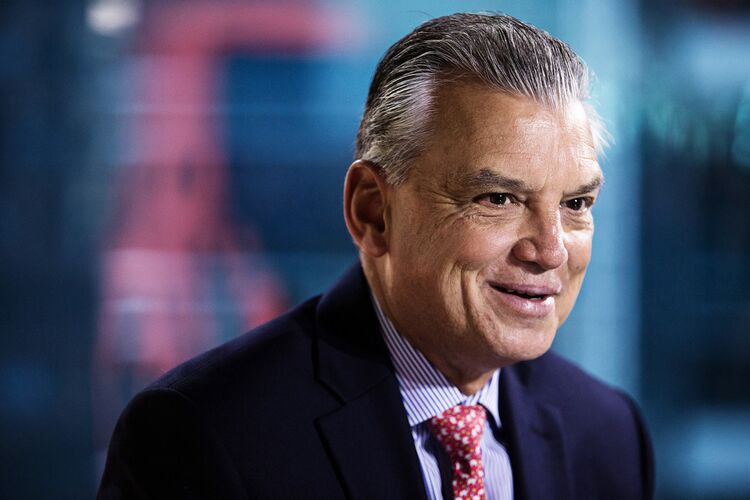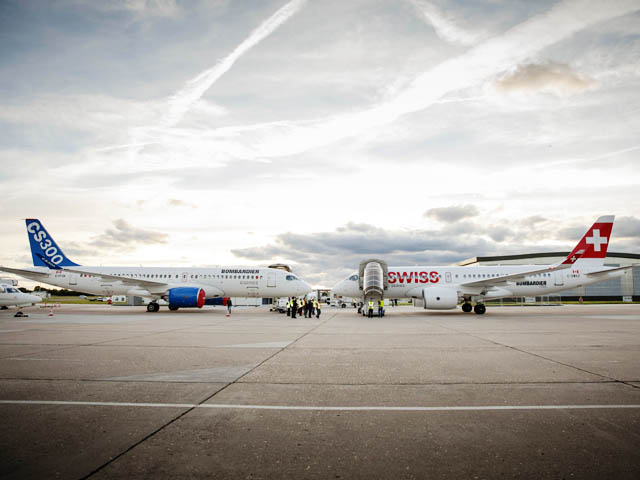Leeham News and Analysis
There's more to real news than a news release.
New single aisles on home stretch
By Bjorn Fehrm
16 Sep 2015, © Leeham Co.: Boeing released pictures yesterday of the first 737 MAX 8 being on the Renton Final Assembly Line (FAL) having completed the wing-to-body joins. With the Airbus A320neo now flying again with both Pratt & Whitney GTF and CFM LEAP test vehicles and Bombardier completing 85% on CSeries (having passed 2,400 hours of flight testing), one can say the new single aisles are on their home stretch.
Original planning had the CSeries entering service in December 2013, nearly two years before A320neo (October 2015) and four years before the 737 MAX (4Q2017). With the 737 MAX now on the FAL one can start to review the Entry into Service (EIS) for all three. It will be tighter than the companies have said.
Posted on September 16, 2015 by Bjorn Fehrm
Flying CS100 over a noise-sensitive airport
Bombardier’s CS100 made its first visit to Toronto today and in the process overflew the City’s Billy Bishop Airport, which is located just off downtown in a noise-sensitive area.

The Bombardier CS100 overflies Toronto Billy Bishop Airport during its first visit to the City.
Porter Airlines, which is based at Billy Bishop, has a large conditional order for the CS100. The plan requires extending the runway at both ends and gaining governmental approval to operate commercial jets there. Right now only turbo-props are allowed for airline operations.
There is substantial opposition from the plan, including from rival Air Canada. For the public, it’s mostly about noise. For Air Canada, it’s the competitive advantage Porter would have operating out of close-in Bishop while AC is at the more distant Pearson Airport.
CS100 noise tests indicate it is quieter than the Bombardier Q400 Porter flies from Bishop. The CS100 overflights are obviously a demonstration of the noise profile of CS100 operations at Bishop.
Posted on September 10, 2015 by Scott Hamilton
Embraer faces new challenge from MRJ90
Part 2

Paulo Cesar, president and CEO of Embraer’s commercial aviation unit. Photo via Google images.
Sept. 10, 2015, © Leeham Co. Embraer is the dominant producer of commercial aircraft in the 70-125 seat sector, having overtaken Bombardier in the last decade following the development and 2004 introduction of the E-Jet. Bombardier’s CRJ family struggles, hampered by a sales force that neglected it and the Q400 turbo-prop as attention focused on the new CSeries.
Embraer in recent years faced new competition. However, the early entries—AVIC’s ARJ21 and the Sukhoi Superjet SJ100, both in the 70-90 seat sector, proved little to worry about. The ARJ21, now eight years late, proved to be a technological and industrial dud, a project that was more about learning how to design and build an airplane than producing a commercially viable one.
The SSJ100, while winning favorable reviews, was and continues to be plagued by a poor production system and in recent years the political overhang of Russia’s annexation of Crimea and its war in Ukraine.
Shortly, though, the E-190 faces a new challenger: the Mitsubishi MRJ90. It’s two years late, now forecasting an entry-into-service of 2017—just one year ahead of the redesigned E-190, the E-190 E2. The MRJ90, a 90-seat clean-sheet design, is Japan’s first commercial airliner since the NAMC YS-11 turbo-prop of the 1960s. The MRJ90’s first flight is scheduled for the second half of next month. Full flight testing moves to Washington State in the first quarter next year.
Posted on September 10, 2015 by Scott Hamilton
Airbus, Airlines, Boeing, Bombardier, CSeries, Embraer, Lockheed Martin, McDonnell Douglas, Mitsubishi
767, A320, A400M, Airbus, Boeing 737, Bombardier, C-130, CRJ, E-175, E-175-E2, E-190, E-190 E2, E-195, E-Jet, Embraer, International Aero Engines, KC-390, Lockheed Martin, McDonnell Douglas, MD-90, Mitsubishi, MRJ90, Paulo Cesar, Q400, SkyWest Airlines, Trans States Airlines, V2500
Embraer CEO sees opportunity for 100-seaters in USA
Part 1
Sept. 9, 2015, © Leeham Co.: The chief executive officer of Embraer’s commercial aircraft unit believes a trend might be emerging for US major airlines to directly operate 100- and plus-100 seat aircraft (and below the 125-seat sector), opening new opportunities currently precluding the largest E-Jets, and by implication, competing jets.

Paulo Cesar, president and chief executive officer of Embraer’s commercial airplane unit. Photo via Google images.
US major airlines have generally migrated away from the 100-125 seat aircraft, up-gauging to the 150-162 seat Airbus A320s and Boeing 737-800s and their re-engined successor. The “baby” Airbus and Boeing aircraft, the A319ceo/neo and 737-700/7, haven’t sold well in recent years.
But the Embraer E-195 E2, at 122 seats in a comfortable single-class configuration and somewhat smaller in two class, hasn’t yet penetrated the US market. Neither has the Bombardier CS100, a 100-110 seat aircraft in two- or single-class configuration.
Delta Air Lines is bucking history with acquisition of 88 inexpensive Boeing 717s from the used airplane market. Southwest Airlines and United Airlines are acquiring used 737-700s and United agreed to lease in 25 used A319s.
Cheap fuel and cheap capital costs help these decisions. But Paulo Cesar, president and CEO of Embraer’s commercial unit, sees an opportunity for his airplane.
Posted on September 9, 2015 by Scott Hamilton
Bombardier snares Lufthansa’s Nico Buchholz
Bombardier scored a major executive coup with the appointment of Nico Buchholz as Chief of Procurement for the entire company.

Nico Buchholz, the new Head of Procurement for Bombardier. Photo via Google images.
Buchholz was Executive VP Group Fleet Management for Lufthansa Airlines and Group, with various fleet management titles, since 2001. He previously was an executive at Airbus.
Buchholz was the launch customer for the CSeries, placing an order in 2009 for 30+30 CS100s and CS300s. Lufthansa Group’s Swiss International Airlines subsidiary will become the first operator when the deliveries begin next year. While the Middle Eastern airlines get the headlines for being launch customers for the Boeing 777X, in fact it was Buchholz who bought the airplane for Lufthansa, which is the first 777-9 customer.
Buchholz is a major “get” for Bombardier.
Posted on September 8, 2015 by Scott Hamilton
Pontifications: Airbus flies past Boeing in order race
Sept. 7, 2015, © Leeham Co.: Airbus flew past Boeing in the annual orders race when the August numbers were reported last week by both companies.
With the order for 250 A320s finally firmed up by India’s Indigo Airlines (it was announced last year), and an order for 45 A330ceos announced by China, the outcome was clear.
Through August, Airbus now has a 66% market share of single-aisle orders. Boeing has a 60% share of wide-body orders, thanks to a boost from FedEx for 50 767-300ERFs. (Boeing reported 48 767 orders net of cancellations.)
But if you remove the FedEx orders and just look at passenger airplanes, Airbus edges out Boeing in the year-to-date wide-body market share.
Posted on September 7, 2015 by Scott Hamilton
Union leaders stall contract vote for Republic
Republic Airways Holdings appeared to resume its downward trajectory toward a potential bankruptcy when the leadership of its pilots union refused to put the  company’s last, best and final and final offer for a new pilot contract.
company’s last, best and final and final offer for a new pilot contract.
Republic subsidiaries provide regional airline service to American, Delta and United airlines.
Republic says pilot shortages caused it to reduce operations. Pay raised, benefits and working conditions have been at the heart of the protracted contract negotiations between the company and the Teamsters, which represents the pilots.
Republic previously restructured one of its smaller subsidiaries outside bankruptcy, but with pilot shortages and reduced revenue to support debt service, the situation is worse now than it was then.
Republic also has billions of dollars worth of aircraft orders, with nearly $2.7bn due next year. This includes the first of 40 Bombardier CS300s and a number of Embraer E-Jets.
Posted on September 1, 2015 by Scott Hamilton
Pontifications: Storm warnings ahead
Aug. 17, 2015 (c) Leeham Co: Sometimes I never know what’s going to exercise readers. Sometimes it’s obvious. Last week it wasn’t.
Our post last week about the formidable challenges still facing Bombardier for the CSeries brought some surprising reaction, particularly on Twitter. And I didn’t see it coming.
The story was behind the paywall, but Canada’s National Post saw the public portion and called to get more information. The Post published some comments from an interview and with permission recreated a chart that was behind the paywall.
We’ve been doing risk assessments of “skyline” quality for a couple of years now, including Bombardier, which is why the reaction to last week’s post came as a surprise.
Our risk assessment has taken a couple of forms. For Bombardier, it’s a Green-Yellow-Red assessment, the meaning of which really doesn’t mean any explanation for anyone who drives a car or, in the aerospace industry, has ever seen Boeing’s Green-Yellow-Red assessment of access to aircraft financing it does every year.
The other symbolic method we use is nautical: Storm Warning Flags, looking at the top 10 narrow- and wide-body customers of Airbus and Boeing and raising a Storm Warning Flag about how solid the order is. We do this annually and the most recent time for Airbus and Boeing customers is here, also behind our paywall.
Posted on August 17, 2015 by Scott Hamilton
C Series: challenges ahead
Subscription Required
Introduction

Bombardier CS300 (L) and CS100 (R). Click on image to enlarge. Photo via Google images.
Aug. 10, 2015, (c) Leeham Co. Bombardier came away from the Paris Air Show with positive reviews after finally displaying its new C Series. The CS100 was present in launch operator Swiss International colors and the spacious interior installed. The larger CS300, in house colors, was also on display and performed flying maneuvers, impressing the crowd with the quiet of the Pratt & Whitney P1000G Geared Turbo Fan engines, also a new product. Once airborne and circling around the runway, the engines could not be heard over the loud speakers of the show’s announcer.
BBD officials came away encouraged by response to the airplanes and they said potential customers were stopping by the chalet with new and renewed interest in the program.
But there remain formidable challenges ahead for the program. There were no sales announced at the Air Show, although BBD officials were clear in advance none was expected. None has been announced in the six weeks since the Air Show. Whether there will be any of substance by year end, and to whom, remains to be seen.
Focus is on execution: getting the aircraft certified by year end and preparing for delivery to Swiss in the first half of next year.
But the customer base remains of iffy quality and a number of the deliveries scheduled 2016-2018 fall into Leeham Co.’s Yellow and Risk Risk Assessment.
Summary
- Of nearly 200 deliveries scheduled 2106-1018, more than half fall within our Yellow-Red risk assessment.
- Country and region risk are concerns.
- A major customer has a changing business plan that puts deliveries into a Risk Assessment.
Posted on August 10, 2015 by Scott Hamilton
Pontifications: Talk about government interference in private industry; book review of United “Flight 232”
- There are many topics on which to comment, n one of which requiring a full Pontification, so today’s column is going to be a bit of a free association.
August 10, 2015, (c) Leeham Co. Government interference: While right wing Republicans and Tea Party members decry supposed ExIm Bank interference with private industry, there is now a bill in Congress to sell millions of barrels of oil from the USA’s Strategic Oil Reserve in order to raise $15bn.
Unlike the ExIm Bank’s participation in the global capital markets, Congress’s action–if it passes–won’t create jobs. It will compete with jobs and companies trying to sell oil in the global market place. It will help drive prices down.
Once more, the hypocrisy of Congress is glaringly evident.
Bombardier: Pierre Beaudoin should have left Bombardier last February when he relinquished the title of president and CEO to Alain Bellemare instead of assuming the chairman’s title. This is the opinion of a few people with whom I’ve talked just in the last week.
Furthermore, the Beaudoin family needs to step out of the company entirely and give up its voting control (it has 54% of the voting stock) if BBD wants to attract new investors, says one Canadian aerospace analyst who hasn’t written any of this publicly.
“I can’t even see how they’re going to raise money for BT. I can’t imagine European investors would like subordinate shares either. Equity markets won’t be supportive unless the Family gives up control,” this analyst wrote me.
Posted on August 10, 2015 by Scott Hamilton



